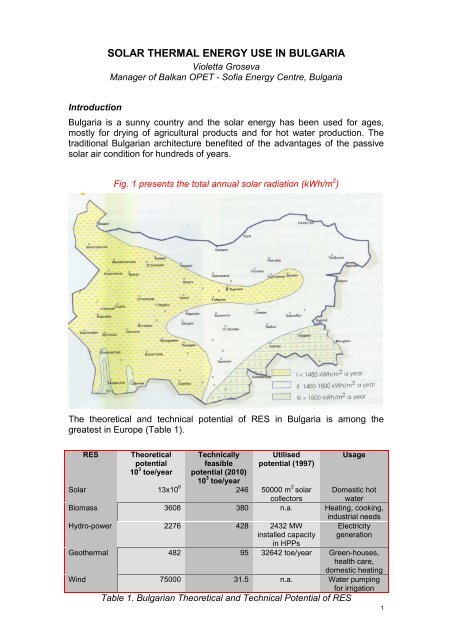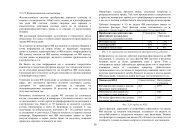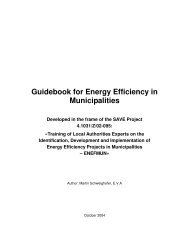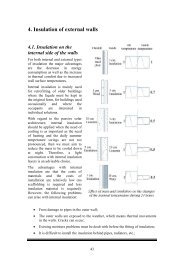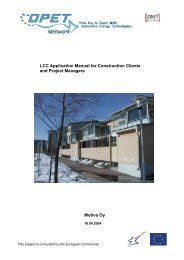Solar Energy Use in Bulgaria
Solar Energy Use in Bulgaria
Solar Energy Use in Bulgaria
You also want an ePaper? Increase the reach of your titles
YUMPU automatically turns print PDFs into web optimized ePapers that Google loves.
SOLAR THERMAL ENERGY USE IN BULGARIA<br />
Violetta Groseva<br />
Manager of Balkan OPET - Sofia <strong>Energy</strong> Centre, <strong>Bulgaria</strong><br />
Introduction<br />
<strong>Bulgaria</strong> is a sunny country and the solar energy has been used for ages,<br />
mostly for dry<strong>in</strong>g of agricultural products and for hot water production. The<br />
traditional <strong>Bulgaria</strong>n architecture benefited of the advantages of the passive<br />
solar air condition for hundreds of years.<br />
Fig. 1 presents the total annual solar radiation (kWh/m 2 )<br />
The theoretical and technical potential of RES <strong>in</strong> <strong>Bulgaria</strong> is among the<br />
greatest <strong>in</strong> Europe (Table 1).<br />
RES<br />
Theoretical<br />
potential<br />
10 3 toe/year<br />
Technically<br />
feasible<br />
potential (2010)<br />
10 3 toe/year<br />
Utilised<br />
potential (1997)<br />
Usage<br />
<strong>Solar</strong> 13x10 6 246 50000 m 2 solar<br />
collectors<br />
Domestic hot<br />
water<br />
Biomass 3608 380 n.a. Heat<strong>in</strong>g, cook<strong>in</strong>g,<br />
<strong>in</strong>dustrial needs<br />
Hydro-power 2276 428 2432 MW<br />
<strong>in</strong>stalled capacity<br />
<strong>in</strong> HPPs<br />
Electricity<br />
generation<br />
Geothermal 482 95 32642 toe/year Green-houses,<br />
health care,<br />
domestic heat<strong>in</strong>g<br />
W<strong>in</strong>d 75000 31.5 n.a. Water pump<strong>in</strong>g<br />
for irrigation<br />
Table 1. <strong>Bulgaria</strong>n Theoretical and Technical Potential of RES<br />
1
The technical potential of solar energy is distributed as follows:<br />
10 3 toe/year %<br />
Photo voltaic panels 52 21<br />
Active solar thermal energy systems 161 66<br />
Passive solar thermal energy systems 33 13<br />
Total 246 100<br />
Current status of solar thermal <strong>in</strong>stallations <strong>in</strong> <strong>Bulgaria</strong><br />
It is evident that 66 % of technical solar potential belong to the active solar<br />
thermal energy systems, which are mostly applied until now; therefore only<br />
these will be considered <strong>in</strong> the present report. It should be mentioned that PV<br />
modules are, so to say, symbolic. <strong>Bulgaria</strong> was the leader <strong>in</strong> Eastern Europe<br />
<strong>in</strong> design and production of solar thermal <strong>in</strong>stallations. The first <strong>Bulgaria</strong>n<br />
solar thermal collectors have been of panel type radiators with area of 2 m 2 ,<br />
next step of design was the flat plate collectors with area of 1,46 and 1,76 m 2 .<br />
The first <strong>Bulgaria</strong>n solar collector was designed and produced <strong>in</strong> 1977. The<br />
state enterprise “New <strong>Energy</strong> Sources” (NES) was <strong>in</strong> a position to solve<br />
technical problems related to research, design, test<strong>in</strong>g, manufactur<strong>in</strong>g and<br />
assembl<strong>in</strong>g of solar thermal <strong>in</strong>stallations. NES implemented a large-scale<br />
governmental programme for design<strong>in</strong>g, the manufacture and <strong>in</strong>stallation of<br />
50 000 m 2 solar collectors. These collectors were <strong>in</strong>stalled dur<strong>in</strong>g 1977-90<br />
ma<strong>in</strong>ly <strong>in</strong> the tourist facilities for hot water supply at the Black Sea coast. Fig.<br />
2 presents the regional distribution of these solar thermal <strong>in</strong>stallations.<br />
Sofia -region<br />
11%<br />
Ruse<br />
2%<br />
Haskovo<br />
11%<br />
Sofia -town<br />
4%<br />
Burgas<br />
41%<br />
Plovdiv<br />
11%<br />
M ontana<br />
2%<br />
Lovetch<br />
2%<br />
Varna<br />
16%<br />
Fig. 2<br />
Most of the collectors <strong>in</strong>stalled comprise of steel absorbers, black coat<strong>in</strong>g,<br />
s<strong>in</strong>gle glass cover and galvanized steel collector surround<strong>in</strong>g. The pipes for<br />
<strong>in</strong>stallations are 99 % from steel.<br />
Arbeitsgeme<strong>in</strong>schaft ERNEUERBARE ENERGIE – AEE, supported by the<br />
Austrian M<strong>in</strong>istry of Environment and Youth, implemented <strong>in</strong> 1998-99 the<br />
project “Statistic evaluation and analysis of large-scale <strong>Bulgaria</strong>n solar<br />
2
<strong>in</strong>stallations”. The report overviews <strong>in</strong> detail the situation of large-scale solar<br />
<strong>in</strong>stallation <strong>in</strong> three regions of <strong>Bulgaria</strong> – Burgas, Plovdiv and Sofia. Detailed<br />
surveys had been done, review<strong>in</strong>g the present condition of the various<br />
elements of solar collectors and <strong>in</strong>stallations. The ma<strong>in</strong> conclusions are very<br />
characteristic and significant for the solar thermal <strong>in</strong>stallations market <strong>in</strong> the<br />
country and also review the ma<strong>in</strong> factors <strong>in</strong>fluenc<strong>in</strong>g it.<br />
- The <strong>in</strong>stallation of 50 000 m 2 solar collectors for the period 1977-90 was<br />
made <strong>in</strong> the framework of a governmental programme and was f<strong>in</strong>anced<br />
by the government, local authorities, etc.<br />
- This policy was not related with the market penetration of solar thermal<br />
<strong>in</strong>stallations for households, small hotels, etc.<br />
- The low energy prices of the fuels and electricity at that time and<br />
<strong>in</strong>competitiveness of the price of a solar energy<br />
- S<strong>in</strong>ce 1990, <strong>Bulgaria</strong> is <strong>in</strong> transition and major part of the tourism facilities<br />
and <strong>in</strong>dustrial enterprises have been privatized or undergo<strong>in</strong>g this<br />
procedure. This is one of the reasons for the poor ma<strong>in</strong>tenance, lead<strong>in</strong>g to<br />
the present bad status of the <strong>in</strong>stallations.<br />
54 % of the <strong>in</strong>stallations <strong>in</strong> the tourist facilities are still operational, but for<br />
the <strong>in</strong>dustrial sector – these are only 8 %.<br />
- Major part of the exist<strong>in</strong>g <strong>in</strong>stallations require repair. The ma<strong>in</strong> problems<br />
are the corrosion of steel collector surround<strong>in</strong>g and the absorber coat<strong>in</strong>gs,<br />
lack of frost protection; broken glasses, etc.<br />
Dur<strong>in</strong>g the last 10 years, the prices of the energy carriers (electricity, heat,<br />
liquid fuels, etc.), have been many times <strong>in</strong>creased and are closer now to<br />
those of the European market. Thus, the ma<strong>in</strong> barrier – low energy prices –<br />
has been elim<strong>in</strong>ated. The new private companies and the population start<br />
<strong>in</strong>vestigat<strong>in</strong>g the possibility of energy efficiency and utilisation of new energy<br />
sources and ma<strong>in</strong>ly solar energy.<br />
Dur<strong>in</strong>g the last years, many demonstration projects have been implemented<br />
under various programmes on solar thermal utilisation <strong>in</strong> <strong>Bulgaria</strong>.<br />
Sofia <strong>Energy</strong> Centre took part <strong>in</strong> the implementation of energy efficient solar<br />
system <strong>in</strong> the k<strong>in</strong>dergarten “Alen Mak” <strong>in</strong> the town of Veliko Turnovo (1998),<br />
for domestic hot water production and hot water supply for the swimm<strong>in</strong>g pool.<br />
The solar collectors manufactured by Kaloria S.A. – Greece, have been<br />
<strong>in</strong>stalled <strong>in</strong>to 2 systems, each with 8 collectors featur<strong>in</strong>g effective area of<br />
15,44 m 2 . Each system is connected with a boiler ISOTHERM, 800 l, with a<br />
special construction of 2 serpent<strong>in</strong>es. The system is characterized of<br />
comb<strong>in</strong>ed cycle of operation – mak<strong>in</strong>g use of solar energy, heat energy and<br />
electricity. The heat carrier of the cycle solar collector – boiler, is antifreeze.<br />
Thus the <strong>in</strong>stallation can be used dur<strong>in</strong>g the whole year period. The antifreeze<br />
circulation is a closed cycle and driven by a pump with electronic<br />
programm<strong>in</strong>g device. The second serpent<strong>in</strong>e heats the water <strong>in</strong> the boiler<br />
through the hot water derived from the heat exchanger of the district heat<strong>in</strong>g<br />
system. The water may also be heated by a 4 kW electric heater.<br />
Another demonstration project – <strong>Solar</strong> thermal <strong>in</strong>stallations for various types<br />
of build<strong>in</strong>gs (blocks of flats, houses, restaurants, pizzerias, etc.) has been<br />
realised by Sofia <strong>Energy</strong> Centre <strong>in</strong> 1996. The solar collectors have also been<br />
manufactured <strong>in</strong> Greece.<br />
3
With<strong>in</strong> the PHARE programme, different solar thermal demo projects have<br />
been implemented. Table 2 presents technical data and f<strong>in</strong>ancial and<br />
ecological benefits of 3 projects <strong>in</strong> hospitals <strong>in</strong> Southern <strong>Bulgaria</strong>.<br />
No Parameters Measure Stara Zagora Radnevo Krumovgrad<br />
1. Investments EUR 116970 62190 34005<br />
2. Fuel sav<strong>in</strong>gs – oil gas t/year 38.0 19.1 10.5<br />
3. Cost sav<strong>in</strong>gs EUR/year 7994 4750 2973<br />
4. Simple pay-back period Years 16.4 15.9 16.0<br />
5. <strong>Solar</strong> collectors – area m 2 405 210 110<br />
6. Accumulation volume l 7000 5000 3500<br />
7. Hot water consumption <strong>in</strong>cl. MWh/y 352 198 92<br />
distribution losses<br />
8. Measured production KWh/m 2 /y 501 550 572<br />
9. Measured production MWh/y 203 116 62<br />
10. SC cover summer/w<strong>in</strong>ter % 100/25 100/25 100/32<br />
11. Reduced CO 2 emissions t/year 71.01 40.44 22.03<br />
12. Reduced SO 2 emissions t/year 0.48 0.27 0.15<br />
13. Reduced NO x emissions t/year 1.44 0.82 0.45<br />
14. Particles t/year 0.10 0.05 0.03<br />
Table 2. F<strong>in</strong>ancial, technical and ecological data and results<br />
Table 3 presents 5 solar thermal demo-projects <strong>in</strong> Northern <strong>Bulgaria</strong>. The first<br />
three of them were of plate solar water collectors (made <strong>in</strong> <strong>Bulgaria</strong>) – bivalent<br />
<strong>in</strong>stallation for hot water with driven circulation.<br />
For the ZEMUS enterprise, two bivalent solar systems have been designed,<br />
each one compris<strong>in</strong>g of 2 groups of four modules. Each module comprised of<br />
a solar collector and a boiler, work<strong>in</strong>g <strong>in</strong> a gravitation regime.<br />
The fifth project is solar dryer for the wood process<strong>in</strong>g enterprise and is<br />
<strong>in</strong>tegrated <strong>in</strong> the roof.<br />
No Parameter Measure K<strong>in</strong>dergarten<br />
“Eugenia<br />
Kissimova”,<br />
Veliko<br />
Turnovo *<br />
“ELIOT” Ltd,<br />
Veliko<br />
Turnovo *<br />
Sanatorium<br />
<strong>in</strong> Ovcha<br />
mogila<br />
village *<br />
Zemus EMOS –<br />
Ltd. * <strong>Solar</strong><br />
Dryer *<br />
1. Investments EUR 5561 5561 4661 5702 5000 **<br />
2. Fuel sav<strong>in</strong>gs t/year 1.6 1.8 1.1 1.2 6.5<br />
3. Cost sav<strong>in</strong>gs EUR/year 411 444 282 304 1625 ***<br />
4. Simple pay-back Years 13.5 12.5 16.5 19.0<br />
period<br />
3.1 **<br />
5. <strong>Solar</strong> collectors m 2 21 21 15 13 100<br />
area<br />
6. Accumulation<br />
l 1500 1500 1200 640 -<br />
volume<br />
7. Measured<br />
KWh/m 2 /y 400 **** 432 401 462 -<br />
production<br />
8. Measured<br />
MWh/y 8410 9065 6008 6007 -<br />
production<br />
9. SC cover<br />
summer/w<strong>in</strong>ter<br />
% 54/0 56/0 52/0 34/0 100/0<br />
Table 3 F<strong>in</strong>ancial and technical data for the 5 projects<br />
* The sav<strong>in</strong>gs are for the session April – October <strong>in</strong>stead of a whole year<br />
** The total <strong>in</strong>vestments are 36840 EUR for the whole construction of the solar dryers. The <strong>in</strong>vestment only for the<br />
transparent part and its construction, i.e. the solar part is 5000 EUR.<br />
*** The measured cost sav<strong>in</strong>gs is 1625 EUR/year. The theoretical cost sav<strong>in</strong>g is 1960 EUR/year<br />
**** The production, i.e. the efficiency is less than projected because of trees shadow<strong>in</strong>g.<br />
4
Besides the projects implemented under various programmes, demonstration<br />
projects on large-scale solar <strong>in</strong>stallations, there are some solar collectors<br />
<strong>in</strong>stalled <strong>in</strong> private hotels and new houses. Part of them is produced <strong>in</strong><br />
<strong>Bulgaria</strong>, but the rest are imported from different EU countries (Greece,<br />
France, Germany, etc.)<br />
<strong>Bulgaria</strong>n solar thermal market<br />
The majority of <strong>in</strong>stalled solar collectors dur<strong>in</strong>g the last years <strong>in</strong> public<br />
build<strong>in</strong>gs and <strong>in</strong> <strong>in</strong>dustrial enterprises are implemented under different<br />
programmes. The annual market of solar collectors for household systems is<br />
rather low, because a great part of the population currently faces enormous<br />
f<strong>in</strong>ancial problems and the people be<strong>in</strong>g worried about their energy bills do<br />
not dispose of f<strong>in</strong>ance to <strong>in</strong>vest <strong>in</strong> solar systems. 90 % of the sales of solar<br />
collectors belong to those who are build<strong>in</strong>g new houses or new private hotels.<br />
The technologies applied for solar thermal energy conversion are the same as<br />
the ones applied <strong>in</strong> other European countries.<br />
The solar thermal <strong>in</strong>stallations are ma<strong>in</strong>ly for:<br />
- hot water <strong>in</strong> public build<strong>in</strong>gs (hospital, k<strong>in</strong>dergarten, etc.) <strong>in</strong> domestic and<br />
tourist sectors;<br />
- solar dryers <strong>in</strong> the wood process<strong>in</strong>g and agricultural products <strong>in</strong>dustries.<br />
The estimated market potential at present is around 5000 m 2 of collectors per<br />
year. The cost of the <strong>Bulgaria</strong>n solar collectors is only 100-150 $/m 2 and 250-<br />
290 $/m 2 for the entire systems.<br />
There are five bigger enterprises <strong>in</strong> <strong>Bulgaria</strong>, which produce solar collectors.<br />
There are a number of small and medium-sized companies produc<strong>in</strong>g solar<br />
collectors but these are not equipped with technological l<strong>in</strong>es, and most of the<br />
solar collectors feature various design defects. It would be more beneficial to<br />
import at least the absorbers and the rest to be produced and assembled <strong>in</strong><br />
<strong>Bulgaria</strong>.<br />
It must be noted that there is no laboratory <strong>in</strong> <strong>Bulgaria</strong> for test<strong>in</strong>g solar<br />
collectors, therefore no quality certificate can be granted for collectors made<br />
<strong>in</strong> <strong>Bulgaria</strong>.<br />
There are also many distributors of different types of solar collectors (Greek,<br />
German, French, etc.).<br />
Barriers for implementation of solar thermal <strong>in</strong>stallations<br />
In conclusion it may be summarised that <strong>Bulgaria</strong> has a substantial solar<br />
potential and a limited scope of its utilisation. To a great extend it is due to the<br />
fact that for a long period between 1944-90 the state policy applied symbolic<br />
prices of the energy sources (electricity, heat, etc.) and the development of<br />
RES utilisation and therefore – of the RES <strong>in</strong>dustry, did not meet the required<br />
fundament to beg<strong>in</strong>. The demonstration projects implemented dur<strong>in</strong>g the last<br />
years, undoubtedly, contribute to the solar thermal applications development,<br />
but at the present moment RES hardly form 0,4% of the national energy<br />
balance. The solar collectors share <strong>in</strong> RES is only 4,5 % <strong>in</strong>stalled capacity<br />
and 2,1 % generated energy. The barriers for development of RES and<br />
especially for solar thermal <strong>in</strong>stallations are as follows:<br />
5
1. Institutional barriers:<br />
- Lack of a national programme for the development of renewable energy<br />
sources and the related technologies.<br />
- The various state <strong>in</strong>stitutions, although hav<strong>in</strong>g a positive attitude towards<br />
renewables, still do not pay the necessary attention to these energy<br />
sources.<br />
- Lack of regional and municipal structures, deal<strong>in</strong>g with energy plann<strong>in</strong>g<br />
and utilization of RES.<br />
- Lack of related codes and standards cover<strong>in</strong>g the technical requirements<br />
of the equipment and <strong>in</strong>stallations.<br />
- There are no authorised laboratories for quality control of the produced<br />
equipment.<br />
2. F<strong>in</strong>ancial barriers:<br />
- There are no state funds <strong>in</strong> <strong>Bulgaria</strong> for the development of RES utilisation<br />
and technologies. Such a fund would support to a greater extend the<br />
implementation of various RES projects, <strong>in</strong>clud<strong>in</strong>g solar thermal<br />
<strong>in</strong>stallations.<br />
- The <strong>Bulgaria</strong>n commercial banks have very prudent credit<strong>in</strong>g policy – high<br />
<strong>in</strong>terest rate (usually over 15 %) and credit guarantee more than 125 %.<br />
They absta<strong>in</strong> from grant<strong>in</strong>g long-term credits. Currently this burdens the<br />
small and medium size enterprises <strong>in</strong> produc<strong>in</strong>g solar collectors and solar<br />
thermal <strong>in</strong>stallations.<br />
- In some cases the renewable energy is still more expensive than the<br />
consumer price of heat and electricity. The pay-back period for solar<br />
thermal <strong>in</strong>stallations is more than 10 years.<br />
3. Legal framework<br />
The new <strong>Energy</strong> and <strong>Energy</strong> Efficiency Law (1999) treats only generally<br />
RES. Renewables are still not considered a priority <strong>in</strong> legislation and there<br />
are no <strong>in</strong>centives for their utilisation, <strong>in</strong>clud<strong>in</strong>g solar thermal <strong>in</strong>stallations as<br />
well.<br />
Opportunities assist<strong>in</strong>g RES (<strong>in</strong>clud<strong>in</strong>g solar energy)<br />
• The prices of conventional energy have <strong>in</strong>creased many times.<br />
Nevertheless, the energy market is still not liberalized. Under the<br />
<strong>in</strong>ternational pressure for liberalization of the energy sector, the energy<br />
prices soon will be <strong>in</strong> l<strong>in</strong>e with the <strong>in</strong>ternational levels and RES will be<br />
more competitive.<br />
• Environmental awareness is grow<strong>in</strong>g and RES are seen as a clean future<br />
source of energy<br />
• Decentralisation of the state regulation and the larger autonomy of the<br />
local and regional authorities leads to development of their natural<br />
resources as they see triple dividends: environmental improvement,<br />
economic development and <strong>in</strong>creased employment.<br />
6
Conclusions<br />
The prospects for development of solar thermal <strong>in</strong>stallations <strong>in</strong> <strong>Bulgaria</strong> by the<br />
year 2010 are to <strong>in</strong>crease to 300 000 m 2 solar collectors. The <strong>in</strong>vestments<br />
required are 26 million EURO at payback period between 7 and 10 years. To<br />
achieve these prospects, the follow<strong>in</strong>g should be underl<strong>in</strong>ed:<br />
- The development and admission of a National Strategy and Programme<br />
on renewables, <strong>in</strong>clud<strong>in</strong>g on solar thermal implementation <strong>in</strong> <strong>Bulgaria</strong> is<br />
imperious <strong>in</strong> view to assist the <strong>in</strong>vestment process.<br />
- The government should assist the <strong>in</strong>vestment for solar <strong>in</strong>stallations by<br />
discharg<strong>in</strong>g the taxes on RES projects and thus reduc<strong>in</strong>g the cost of the<br />
<strong>in</strong>stallations.<br />
- Low <strong>in</strong>terest rates, grants and other f<strong>in</strong>ancial schemes are equally<br />
important to activate the <strong>in</strong>vestments for solar applications.<br />
- Jo<strong>in</strong>t venture companies establishment <strong>in</strong> <strong>Bulgaria</strong> and application of the<br />
newest technologies for modern solar collectors production is also very<br />
important.<br />
- Establishment of a test<strong>in</strong>g laboratory for solar collectors <strong>in</strong> <strong>Bulgaria</strong>. This<br />
will facilitate the quality certification of the <strong>Bulgaria</strong>n solar collectors and<br />
will help further promotion of these not only to the <strong>Bulgaria</strong>n market, but<br />
also will facilitate their export.<br />
- The RES utilisation is a new philosophy <strong>in</strong> our country, and requires a new<br />
way of th<strong>in</strong>k<strong>in</strong>g and new approach for RES development. Jo<strong>in</strong>t efforts are<br />
necessary, both on the part of state with its regulatory functions, and on<br />
the part of the entrepreneurs and f<strong>in</strong>anc<strong>in</strong>g <strong>in</strong>stitutions. Regional and<br />
national <strong>in</strong>formation campaigns are needed, show<strong>in</strong>g the advantages of<br />
RES utilisation for the energy sav<strong>in</strong>g and for the environment.<br />
7


